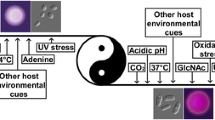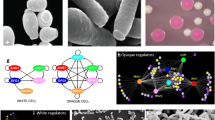Abstract.
For microorganisms that grow over a wide range of extracellular pH, systems must have evolved to sense and respond appropriately. The human opportunistic pathogen Candida albicans colonizes and infects anatomical sites of diverse pH, including the oral and gastro-intestinal tracts and the vaginal cavity. The ability to sense and respond to neutral-alkaline environments is governed by signal transduction pathways, one of which culminates in the activation of the transcription factor, Rim101p. The RIM101/pacC pathway, which governs pH responses and differentiation, has been the focus of study in both Saccharomyces cerevisiae and Aspergillus nidulans. This pathway has been identified in C. albicans and governs pH responses, dimorphism, and pathogenesis. Although C. albicans and S. cerevisiae are related fungi, it is becoming apparent that there are unique aspects of the pH response and the role the RIM101 pathway plays in this response in C. albicans.


Similar content being viewed by others
References
Arst HN Jr, Bignell E, Tilburn J (1994) Two new genes involved in signalling ambient pH in Aspergillus nidulans. Mol Gen Genet 245:787–790
Braun BR, Head WS, Wang MX, Johnson AD (2000) Identification and characterization of TUP1-regulated genes in Candida albicans. Genetics 156:31–44
Braun BR, Kadosh D, Johnson AD (2001) NRG1, a repressor of filamentous growth in C. albicans, is down-regulated during filament induction. EMBO J 20:4753–4761
Calderone RA (2002) Candida and candidiasis. ASM Press, Washington, D.C.
Csank C, et al (1998) Roles of the Candida albicans mitogen-activated protein kinase homolog, Cek1p, in hyphal development and systemic candidiasis. Infect Immun 66:2713–2721
Davis D, Edwards JE Jr, Mitchell AP, Ibrahim AS (2000a) Candida albicans RIM101 pH response pathway is required for host–pathogen interactions. Infect Immun 68:5953–5959
Davis D, Wilson RB, Mitchell AP (2000b) RIM101-dependent and -independent pathways govern pH responses in Candida albicans. Mol Cell Biol 20:971–978
Davis DA, Bruno VM, Loza L, Filler SG, Mitchell AP (2002) Candida albicans Mds3p, a conserved regulator of pH responses and virulence identified through insertional mutagenesis. Genetics 162:1573–1581
De Bernardis F, Muhlschlegel FA, Cassone A, Fonzi WA (1998) The pH of the host niche controls gene expression in and virulence of Candida albicans. Infect Immun 66:3317–3325
Denison SH, Orejas M, Arst HN Jr (1995) Signaling of ambient pH in Aspergillus involves a cysteine protease. J Biol Chem 270:28519–28522
Denison SH, et al (1998) Putative membrane components of signal transduction pathways for ambient pH regulation in Aspergillus and meiosis in Saccharomyces are homologous. Mol Microbiol 30:259–264
El Barkani A, et al (2000) Dominant active alleles of RIM101 (PRR2) bypass the pH restriction on filamentation of Candida albicans. Mol Cell Biol 20:4635–4647
Espeso EA, Penalva MA (1996) Three binding sites for the Aspergillus nidulans PacC zinc-finger transcription factor are necessary and sufficient for regulation by ambient pH of the isopenicillin N synthase gene promoter. J Biol Chem 271:28825–28830
Espeso EA, et al (1997) Specific DNA recognition by the Aspergillus nidulans three zinc finger transcription factor PacC. J Mol Biol 274:466–480
Espeso EA, et al (2000) On how a transcription factor can avoid its proteolytic activation in the absence of signal transduction. EMBO J 19:719–728
Filler SG, Swerdloff JN, Hobbs C, Luckett PM (1995) Penetration and damage of endothelial cells by Candida albicans. Infect Immun 63:976–983
Fonzi WA (1999) PHR1 and PHR2 of Candida albicans encode putative glycosidases required for proper cross-linking of beta-1,3- and beta-1,6-glucans. J Bacteriol 181:7070–7079
Ghannoum MA, Spellberg B, Saporito-Irwin SM, Fonzi WA (1995) Reduced virulence of Candida albicans PHR1 mutants. Infect Immun 63:4528–4530
Haro R, Garciadeblas B, Rodriguez-Navarro A (1991) A novel P-type ATPase from yeast involved in sodium transport. FEBS Lett 291:189–191
Heinz WJ, et al (2000) Molecular responses to changes in the environmental pH are conserved between the fungal pathogens Candida dubliniensis and Candida albicans. Int J Med Microbiol 290:231–238
Kottom TJ, Thomas CF Jr, Limper AH (2001) Characterization of Pneumocystis carinii PHR1, a pH-regulated gene important for cell wall integrity. J Bacteriol 183:6740–6745
Lamb TM, Mitchell AP (2003) The transcription factor Rim101p governs ion tolerance and cell differentiation by direct repression of the regulatory genes NRG1 and SMP1 in Saccharomyces cerevisiae. Mol Cell Biol 23:677–686
Lamb TM, Xu W, Diamond A, Mitchell AP (2001) Alkaline response genes of Saccharomyces cerevisiae and their relationship to the RIM101 pathway. J Biol Chem 276:1850–1856
Li W, Mitchell AP (1997) Proteolytic activation of Rim1p, a positive regulator of yeast sporulation and invasive growth. Genetics 145:63–73
Lo HJ, Kohler JR, DiDomenico B, Loebenberg D, Cacciapuoti A, Fink GR (1997) Nonfilamentous C. albicans mutants are avirulent. Cell 90:939–949
Maccheroni W Jr, May GS, Martinez-Rossi NM, Rossi A (1997) The sequence of palF, an environmental pH response gene in Aspergillus nidulans. Gene 194:163–167
Madzak C, Blanchin-Roland S, Cordero Otero RR, Gaillardin C (1999) Functional analysis of upstream regulating regions from the Yarrowia lipolytica XPR2 promoter. Microbiology 145:75–87
Mayer CL, Filler SG, Edwards JE Jr (1992) Candida albicans adherence to endothelial cells. Microvasc Res 43:218–226
Mingot JM, et al (1999) Specificity determinants of proteolytic processing of Aspergillus PacC transcription factor are remote from the processing site, and processing occurs in yeast if pH signalling is bypassed. Mol Cell Biol 19:1390–1400
Mingot JM, Espeso EA, Diez E, Penalva MA (2001) Ambient pH signaling regulates nuclear localization of the Aspergillus nidulans PacC transcription factor. Mol Cell Biol 21:1688–1699
Mouyna I, et al (2000) Glycosylphosphatidylinositol-anchored glucanosyltransferases play an active role in the biosynthesis of the fungal cell wall. J Biol Chem 275:14882–14889
Muhlschlegel FA, Fonzi WA (1997) PHR2 of Candida albicans encodes a functional homolog of the pH-regulated gene PHR1 with an inverted pattern of pH-dependent expression. Mol Cell Biol 17:5960–5967
Munn AL, Riezman H (1994) Endocytosis is required for the growth of vacuolar H(+)-ATPase-defective yeast: identification of six new END genes. J Cell Biol 127:373–386
Nakazawa T, Horiuchi H, Ohta A, Takagi M (1998) Isolation and characterization of EPD1, an essential gene for pseudohyphal growth of a dimorphic yeast, Candida maltosa. J Bacteriol 180:2079–2086
Nakazawa T, Takahashi M, Horiuchi H, Ohta A, Takagi M (2000) Cloning and characterization of EPD2, a gene required for efficient pseudohyphal formation of a dimorphic yeast, Candida maltosa. Biosci Biotechnol Biochem 64:369–377
Negrete-Urtasun S, Denison SH, Arst HN Jr (1997) Characterization of the pH signal transduction pathway gene palA of Aspergillus nidulans and identification of possible homologs. J Bacteriol 179:1832–1835
Negrete-Urtasun S, et al (1999) Ambient pH signal transduction in Aspergillus: completion of gene characterization. Mol Microbiol 33:994–1003
Odds FC (1988) Candida and candidosis, 2nd edn. Bailiere Tindall, London
Orejas M, Espeso EA, Tilburn J, Sarkar S, Arst HN Jr, Penalva MA (1995) Activation of the Aspergillus PacC transcription factor in response to alkaline ambient pH requires proteolysis of the carboxy-terminal moiety. Genes Dev 9:1622–1632
Park SH, Koh SS, Chun JH, Hwang HJ, Kang HS (1999) Nrg1 is a transcriptional repressor for glucose repression of STA1 gene expression in Saccharomyces cerevisiae. Mol Cell Biol 19:2044–2050
Phan QT, Belanger PH, Filler SG (2000) Role of hyphal formation in interactions of Candida albicans with endothelial cells. Infect Immun 68:3485–3490
Popolo L, Vai M (1998) Defects in assembly of the extracellular matrix are responsible for altered morphogenesis of a Candida albicans phr1 mutant. J Bacteriol 180:163–166
Popolo L, et al (1993) Physiological analysis of mutants indicates involvement of the Saccharomyces cerevisiae GPI-anchored protein gp115 in morphogenesis and cell separation. J Bacteriol 175:1879–1885
Porta A, Ramon AM, Fonzi WA (1999) PRR1, a homolog of Aspergillus nidulans palF, controls pH-dependent gene expression and filamentation in Candida albicans. J Bacteriol 181:7516–7523
Porta A, Wang Z, Ramon A, Muhlschlegel FA, Fonzi WA (2001) Spontaneous second-site suppressors of the filamentation defect of prr1Δ mutants define a critical domain of Rim101p in Candida albicans. Mol Genet Genomics 266:624–631
Ramon AM, Porta A, Fonzi WA (1999) Effect of environmental pH on morphological development of Candida albicans is mediated via the PacC-related transcription factor encoded by PRR2. J Bacteriol 181:7524–7530
Saporito-Irwin SM, Birse CE, Sypherd PS, Fonzi WA (1995) PHR1, a pH-regulated gene of Candida albicans, is required for morphogenesis. Mol Cell Biol 15:601–613
Sentandreu M, Elorza MV, Sentandreu R, Fonzi WA (1998) Cloning and characterization of PRA1, a gene encoding a novel pH-regulated antigen of Candida albicans. J Bacteriol 180:282–289
Su SS, Mitchell AP (1993a) Identification of functionally related genes that stimulate early meiotic gene expression in yeast. Genetics 133:67–77
Su SS, Mitchell AP (1993b) Molecular characterization of the yeast meiotic regulatory gene RIM1. Nucleic Acids Res 21:3789–3797
Tenney KA, Glover CV (1999) Transcriptional regulation of the S. cerevisiae ENA1 gene by casein kinase II. Mol Cell Biochem 191:161–167
Tilburn J, et al (1995) The Aspergillus PacC zinc finger transcription factor mediates regulation of both acid- and alkaline-expressed genes by ambient pH. EMBO J 14:779–790
Viudes A, Perea S, Lopez-Ribot JL (2001) Identification of continuous B-cell epitopes on the protein moiety of the 58-kiloDalton cell wall mannoprotein of Candida albicans belonging to a family of immunodominant fungal antigens. Infect Immun 69:2909–2919
Weig M, Haynes K, Rogers TR, Kurzai O, Frosch M, Muhlschlegel FA (2001) A GAS-like gene family in the pathogenic fungus Candida glabrata. Microbiology 147:2007–2019
Xu W, Mitchell AP (2001) Yeast PalA/AIP1/Alix homolog Rim20p associates with a PEST-like region and is required for its proteolytic cleavage. J Bacteriol 183:6917–6923
Author information
Authors and Affiliations
Corresponding author
Additional information
Communicated by S. Hohmann
An Erratum to this article can be found at http://dx.doi.org/10.1007/s00294-003-0431-2
Rights and permissions
About this article
Cite this article
Davis, D. Adaptation to environmental pH in Candida albicans and its relation to pathogenesis. Curr Genet 44, 1–7 (2003). https://doi.org/10.1007/s00294-003-0415-2
Received:
Revised:
Accepted:
Published:
Issue Date:
DOI: https://doi.org/10.1007/s00294-003-0415-2




